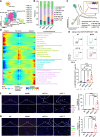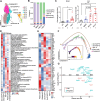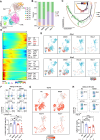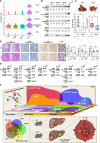Single-cell transcriptome reveals the reprogramming of immune microenvironment during the transition from MASH to HCC
- PMID: 40500691
- PMCID: PMC12153197
- DOI: 10.1186/s12943-025-02370-2
Single-cell transcriptome reveals the reprogramming of immune microenvironment during the transition from MASH to HCC
Abstract
Background: The immunological landscape of metabolic dysfunction-associated steatohepatitis (MASH)-driven hepatocellular carcinoma (HCC) is not well understood. Herein, we aim to delineate the immunological landscape in the MASH-to-HCC transition and to identify the critical genes that contribute to the pathogenesis of MASH-related HCC.
Methods: A well-established MASH-driven HCC mouse model, STAM model, was first constructed. Thereafter, we applied single-cell RNA sequencing (scRNA-seq) analysis of CD45+ cells sorted from livers of mice with normal chow or MASH, as well as paired paracancerous and cancer tissues from mice with HCC. Flow cytometry and multiplexed immunohistochemistry were performed to validate the analysis results of scRNA-seq. Finally, STAM model was applied between apolipoprotein E (ApoE)-deficient mice and wild type controls.
Results: We identified 23 major clusters corresponding to nine populations among 31,822 cells. Obviously, immunosuppressive and exhausted CD4+ T (IKZF2+OX40+FOXP3+CD4+ and GZMK+LAG-3+PD-1+CD4+), CD8+ T (LY49I+LY49G+IKZF2+FOXP3-CD8+, IKZF2+FOXP3+CD8+ and GZMK+LAG-3+PD-1+CD8+) and γδ T cells (γδ Treg and exhausted γδ T cells) were induced in the MASH-to-HCC transition. As MASH-related HCC progressed, B cells matured and differentiated into immunosuppressive cells. Natural killer cells (NKs) were found to be strikingly reduced at HCC stage. Particularly, the activation of liver-infiltrated NK cells was inhibited, leading to attenuation of anti-tumor capacity in the MASH-to-HCC transition. Moreover, tumor-associated macrophages were increased in MASH-related HCC. Importantly, multiple immune cells highly expressed ApoE in HCC, and ablation of ApoE impeded MASH-driven hepatocarcinogenesis by disrupting both ApoE-PI3K-AKT-NF-κB and ApoE-PI3K-AKT-c-Jun/c-Fos signaling pathways.
Conclusions: We illustrate the profound reprogramming of the liver immune microenvironment in the MASH-to-HCC transition and clarify the role of ApoE in MASH-driven HCC, implying that ApoE may serve as a potential therapeutic target for MASH-related HCC.
Keywords: ApoE; Exhaustion; Immunological landscape; Immunosuppressive microenvironment; MASH-to-HCC transition.
© 2025. The Author(s).
Conflict of interest statement
Declarations. Ethics approval and consent to participate: All procedures for animal experiments were performed according to the Animal Ethics Committee of JNU and in accordance with the Guide for the Care and Use of Laboratory Animals (NIH publications Nos. 80–23, revised 1996). This study does not involve human participants. Competing interests: The authors declare no competing interests.
Figures







References
-
- Llovet JM, Kelley RK, Villanueva A, Singal AG, Pikarsky E, Roayaie S, et al. Hepatocellular carcinoma. Nat Rev Dis Primers. 2021;7:6. - PubMed
-
- Rinella ME, Lazarus JV, Ratziu V, Francque SM, Sanyal AJ, Kanwal F, et al. A multisociety Delphi consensus statement on new fatty liver disease nomenclature. J Hepatol. 2023;79:1542–56. - PubMed
MeSH terms
Substances
Grants and funding
- 32100695/National Natural Science Foundation of China
- 32030036/National Natural Science Foundation of China
- 82372797/National Natural Science Foundation of China
- 2023B0303000004/Guangdong Major Project of Basic and Applied Basic Research
- 2020YFA0803502/National Key Research and Development Program of China
LinkOut - more resources
Full Text Sources
Medical
Research Materials
Miscellaneous

